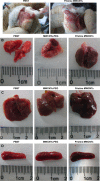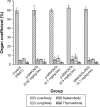Systemic and immunotoxicity of pristine and PEGylated multi-walled carbon nanotubes in an intravenous 28 days repeated dose toxicity study
- PMID: 28280324
- PMCID: PMC5339008
- DOI: 10.2147/IJN.S123345
Systemic and immunotoxicity of pristine and PEGylated multi-walled carbon nanotubes in an intravenous 28 days repeated dose toxicity study
Abstract
The numerous increasing use of carbon nanotubes (CNTs) derived from nanotechnology has raised concerns about their biosafety and potential toxicity. CNTs cause immunologic dysfunction and limit the application of CNTs in biomedicine. The immunological responses induced by pristine multi-walled carbon nanotubes (p-MWCNTs) and PEGylated multi-walled carbon nanotubes (MWCNTs-PEG) on BALB/c mice via an intravenous administration were investigated. The results reflect that the p-MWCNTs induced significant increases in spleen, thymus, and lung weight. Mice treated with p-MWCNTs showed altered lymphocyte populations (CD3+, CD4+, CD8+, and CD19+) in peripheral blood and increased serum IgM and IgG levels, and splenic macrophage ultrastructure indicated mitochondria swelling. p-MWCNTs inhibited humoral and cellular immunity function and were associated with decreased immune responses against sheep erythrocytes and serum hemolysis level. Natural killer (NK) activity was not modified by two types of MWCNTs. In comparison with two types of MWCNTs, for a same dose, p-MWCNTs caused higher levels of inflammation and immunosuppression than MWCNTs-PEG. The results of immunological function suggested that after intravenous administration with p-MWCNTs caused more damage to systemic immunity than MWCNTs-PEG. Here, we demonstrated that a surface functional modification on MWCNTs reduces their immune perturbations in vivo. The chemistry-modified MWCNTs change their preferred immune response in vivo and reduce the immunotoxicity of p-MWCNTs.
Keywords: BALB/c mice; immunosuppression; immunotoxicity; multi-walled carbon nanotubes; surface-functionalized.
Conflict of interest statement
Disclosure The authors report no conflicts of interest in this work.
Figures






Similar articles
-
Exposure to a combination of MWCNTs and DBP causes splenic toxicity in mice.Toxicology. 2022 Jan 15;465:153057. doi: 10.1016/j.tox.2021.153057. Epub 2021 Dec 3. Toxicology. 2022. PMID: 34864091
-
Toxicity of multiwalled carbon nanotubes with end defects critically depends on their functionalization density.Chem Res Toxicol. 2011 Nov 21;24(11):2028-39. doi: 10.1021/tx2003728. Epub 2011 Oct 18. Chem Res Toxicol. 2011. PMID: 21978239
-
Long-term hepatotoxicity of polyethylene-glycol functionalized multi-walled carbon nanotubes in mice.Nanotechnology. 2010 Apr 30;21(17):175101. doi: 10.1088/0957-4484/21/17/175101. Epub 2010 Apr 1. Nanotechnology. 2010. PMID: 20357413
-
Predicting pulmonary fibrosis in humans after exposure to multi-walled carbon nanotubes (MWCNTs).Arch Toxicol. 2016 Jul;90(7):1605-22. doi: 10.1007/s00204-016-1742-7. Epub 2016 May 23. Arch Toxicol. 2016. PMID: 27215431 Review.
-
The impact of multi-walled carbon nanotubes (MWCNTs) on macrophages: contribution of MWCNT characteristics.Sci China Life Sci. 2018 Nov;61(11):1333-1351. doi: 10.1007/s11427-017-9242-3. Epub 2018 May 22. Sci China Life Sci. 2018. PMID: 29797182 Review.
Cited by
-
Unveiling the Bio-corona Fingerprinting of Potential Anticancer Carbon Nanotubes Coupled with D-Amino Acid Oxidase.Mol Biotechnol. 2022 Oct;64(10):1164-1176. doi: 10.1007/s12033-022-00488-y. Epub 2022 Apr 25. Mol Biotechnol. 2022. PMID: 35467257 Free PMC article.
-
Quercetin-Ameliorated, Multi-Walled Carbon Nanotubes-Induced Immunotoxic, Inflammatory, and Oxidative Effects in Mice.Molecules. 2022 Mar 25;27(7):2117. doi: 10.3390/molecules27072117. Molecules. 2022. PMID: 35408516 Free PMC article.
-
Novel insights into nanomaterials for immunomodulatory bone regeneration.Nanoscale Adv. 2021 Nov 29;4(2):334-352. doi: 10.1039/d1na00741f. eCollection 2022 Jan 18. Nanoscale Adv. 2021. PMID: 36132687 Free PMC article. Review.
-
Cytotoxicity-Related Bioeffects Induced by Nanoparticles: The Role of Surface Chemistry.Front Bioeng Biotechnol. 2019 Dec 12;7:414. doi: 10.3389/fbioe.2019.00414. eCollection 2019. Front Bioeng Biotechnol. 2019. PMID: 31921818 Free PMC article. Review.
-
Potential Environmental and Health Implications from the Scaled-Up Production and Disposal of Nanomaterials Used in Biosensors.Biosensors (Basel). 2022 Nov 25;12(12):1082. doi: 10.3390/bios12121082. Biosensors (Basel). 2022. PMID: 36551049 Free PMC article. Review.
References
-
- Ajayan PM, Tour JM. Materials science: nanotube composites. Nature. 2007;447(7148):1066–1068. - PubMed
-
- Kostarelos K, Bianco A, Prato M. Promises, facts and challenges for carbon nanotubes in imaging and therapeutics. Nat Nanotechnol. 2009;4(10):627–633. - PubMed
-
- Laverny G, Casset A, Purohit A, et al. Immunomodulatory properties of multi-walled carbon nanotubes in peripheral blood mononuclear cells from healthy subjects and allergic patients. Toxicol Lett. 2013;217(2):91–101. - PubMed
-
- Wu HC, Chang X, Liu L, Zhao F, Zhao Y. Chemistry of carbon nanotubes in biomedical applications. J Mater Chem. 2010;20(6):1036–1052.
MeSH terms
Substances
LinkOut - more resources
Full Text Sources
Other Literature Sources
Molecular Biology Databases
Research Materials

